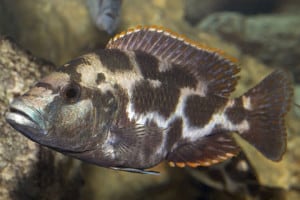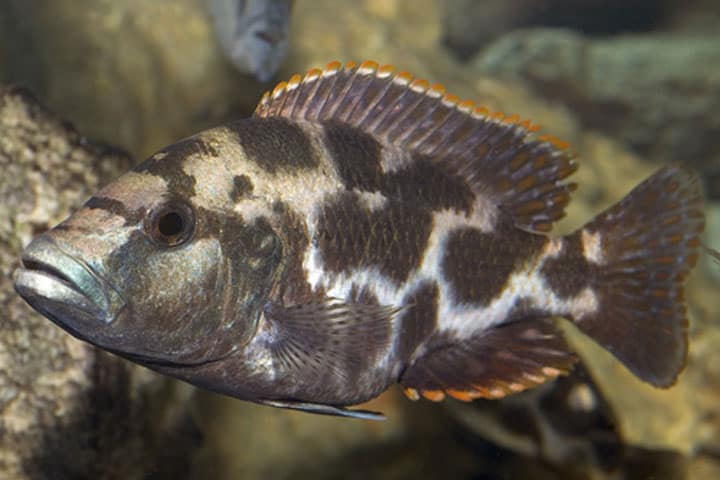
Common name: Livingstonii
Scientific name: Nimbochromis livingstonii, Cyrtocara livingstonii, Haplochromis livingstonii, Hemichromis livingstonii
Average Adult Fish Size: 30cm / 12 Inches
Place of Origin: Lake Malawi
Typical Tank setup: Rocky Malawi tank with plenty of open swimming space
Recommended Minimum Aquarium Capacity: 400 Litres
Compatibility: Other Lake Malawi cichlids, ideally haps and larger malawi cichlids
Temperature: 23-28 Deg C / 73-82 Deg F
Water chemistry: pH 7.6-8.6
Feeding: Omnivorous – Does well with flakes and pellets designed for african cichlids. Diet should be supplimented with live foods such as insect larvae, aquatic insects, fish, earthworms, tubifex worms and crustaceans or green vegetables such as romaine lettuce, spinach, peas or zucchini.
Sexing: Males are generally more colorful. The fin edges are often red in color. Males also have brighter egg spots.
Breeding: Use a large breeding tank with one male and three or four females. Use water with the following propertieS: a pH from 8.0-8.5, a water hardness from 12-18 dH, and a temperature from 81-82°F (27-28°C). Up to 100 eggs are mouthbrooded by the female for a period of 21-24 days. The young can be raised on Artemia and crushed dry foods.
Additional Information: Nimbochromis livingstonii is very similar to its cousin Nimbochromis venustus in many ways. Both are large, active predators that need lots of room to move about. N. livingstonii also has its own unique deceptive method of hunting small Cichlid fry. Nimbochromis livingstonii femaleThis Hap lures unsuspecting fry and other small fish within range by feigning death. It hunts the fry of mbuna and other Cichlids among the rocky and shallow areas of the lake. When this fish finds an area that it wants to hunt, it will lay completely on its side, pretending to be dead, and patiently waits for small fish to come within range. Then, when it’s ready, it leaps off the sand, devouring its prey. This unique method of hunting has earned this fish the name Kaligono by the people living around the lake, which means “sleeper.”


Related Posts
Croaking Gourami – Trichopsis vittatus
Benthochromis Tricoti
Large-eyed Mouthbrooder – Callochromis Macrops